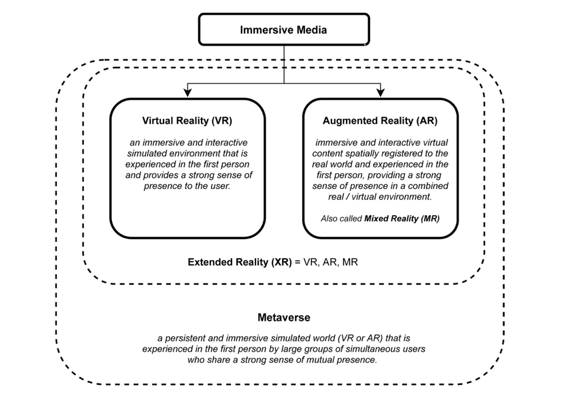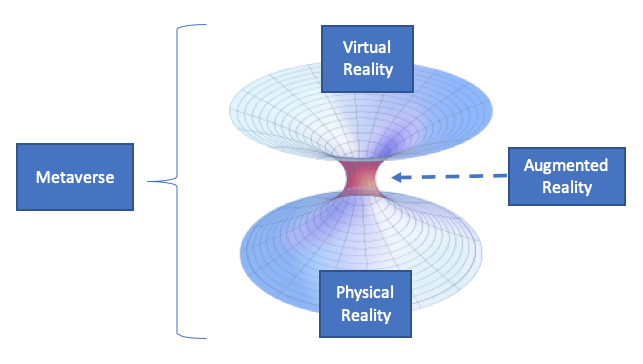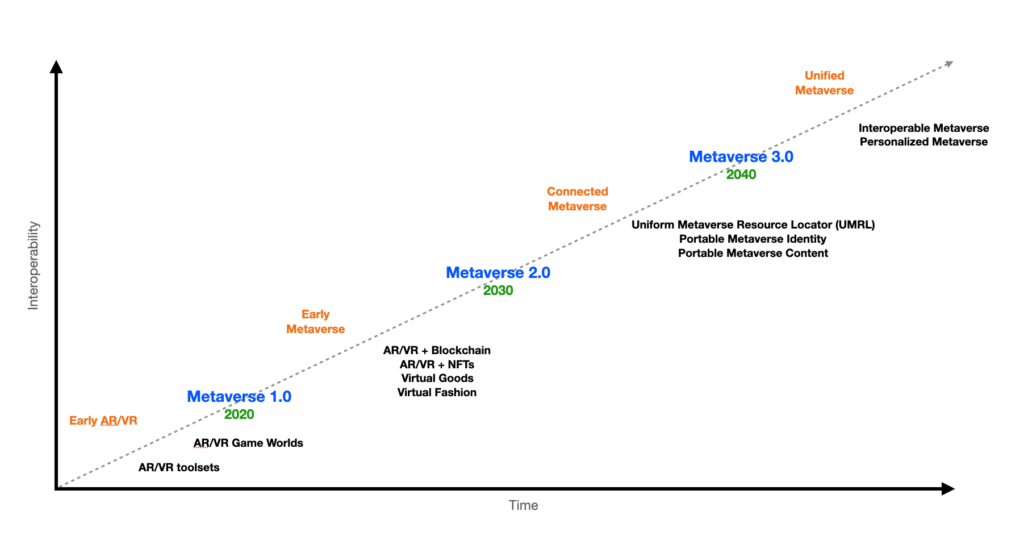In 2009, I published a diagram about the future evolution of the Web, called “Intelligence is in the Connections.” Much of what I predicted has occurred – we have witnessed the growth of social media, natural language search and speech interfaces, intelligent assistants, and massively multiplayer online virtual worlds and games. However, that diagram did not project past 2018, and did not cover the rise of what is now being called the Metaverse. Here I will explore these developments and where I think these trends will go in the decades to come.
The Metaverse has many potential definitions, but one of the better ones that I have encountered recently is from Louis Rosenberg:
A metaverse is a persistent and immersive simulated world that is experienced in the first person by large groups of simultaneous users who share a strong sense of mutual presence. It can be fully virtual and self- contained (a virtual metaverse) or it can exist as layers of virtual content overlaid on the real world (an augmented metaverse). (source: BigThink)
Rosenberg correctly emphasizes that a Metaverse should integrate virtual reality and augmented reality:

One primary challenge that must be overcome to realize this vision are wearable devices that can transition seamlessly from video of the physical world, to augmented video, and then to fully virtual immersive experiences. In the same device, at any location, we need to be able to move back and forth between these dimensions of experience.

For any given location, the content of any relevant augmented reality dimensions will usually be less than that of either the physical reality or virtual reality accessible from that place. Therefore, AR and can be thought of as the electronic equivalent of a wormhole that connects between physical and virtual reality.

The endless detail of physical reality will never be fully augmented – however some subset will be. On the other pole, virtual reality has the potential for infinite content – infinite detail – like the physical world, and so in general the space of potential virtual realities is greater than the space of potential augmented or physical realities. By the definitions above, a Metaverse is space that has at least have one location for which physical, augmented and virtual reality dimensions are connected.
One example of a Metaverse is the game, Pokemon Go. This game connects physical places, augmented content at those places, and a broader game that connects across physical places. However, Pokemon Go, has until recently been a walled garden platform.
Can we build one Metaverse that connects all metaverse applications together? Proponents of this idea envision a future where there is a single Metaverse that is the next level equivalent to the World Wide Web – where much of the content is to some degree connected and interoperable. In order for this to happen there would be need to be a set of standards that content creators and device manufacturers abide by for creating and publishing metaverse applications.
I think that while some standards may emerge, competition between platforms will lead to much of the content being non-interoperable. But despite this, there should be certain aspects of the experience that are portable across metaverse applications
In order to tie different metaverse applications together into a single fabric, or even to merely enable portability of digital identity, money and goods, across these applications, we will need decentralized architectures. This is where blockchain technologies may play a crucial role.
In the years from 2018 to 2022, the shift in emphasis from centralized to decentralized architectures has been gaining strength. One primary example is the growth of interest in distributed ledger technologies.
Various blockchain applications have emerged for everything from currencies and finance, to integrating and tracking trade of goods and services, smart contracts, virtual goods, virtual real- estate, and NFTs. Today we see many early metaverse gaming and virtual real-estate initiatives being built with blockchain architectures.
As we look forward to where these trends are going, there will be alternating phases of integration with standards and fragmentation into walled garden applications, just as we have seen unfolding across decades of the computing and Internet. This dynamic will continue in the metaverse era.

Metaverse 1.0 was the period of time starting from the availability of consumer AR/VR devices and applications – roughly the period of time from 2018 through the 2020’s. These devices were still large, expensive, limited in capabilities, and non-interoperable. During this period of time content and applications will emerge that capture large audience share, but they will primarily be fragmented walled-gardens. User identities and content will largely not be portable from one metaverse application to another.
Metaverse 2.0 will emerge when we start to see meaningful portability of identity and content across metaverse applications. This is difficult to achieve, without import/export controls as well as rules for how these compare between applications. For example, the magic weapon in a fantasy world may not easily map into a realistic modern combat game. Similarly, AR content about a particular brand of car may not be relevant in a future science fiction themed world.
Does it make sense to even attempt to make such items portable across metaverse applications? For the most part the answer is no. However, within certain layers, where the content and purposes of separately hosted applications are compatible, there will be varying degrees of portability and interoperability.
One clear case for interoperability is the need for a standard for referencing the location or address of a place in a metaverse application, and for any item or user identity in the metaverse. We need the metaverse equivalent of the URL, or what we might call a “uniform metaverse resource locator” or UMRL. This simple idea is one of the key enablers of a unified metaverse in the future.
Once we have a standard way of referencing people, places and things across metaverse applications, we will have arrived at Metaverse 2.0. Along with the concept of the UMRL, I can imagine there will eventually be portable and interoperable virtual identities that can move across different metaverses, so that the user can bring certain things with them as they travel from one realm to another. Virtual identities might also carry the user’s avatars, social connections, personal preferences, wallets, and even certain types of virtual goods.
When the evolution of metaverse interoperability reaches maturity we can call this stage Metaverse 3.0 – the Unified Personalized Metaverse. At this time the situation of separate metaverses that are not fully interoperable will dissolve into a more decentralized model where the user’s virtual identity is the platform for a range of metaverse content and services that will be constantly personalized and self-organizing around the interests of the user.